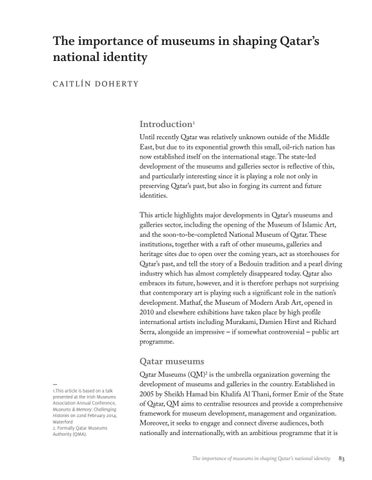The importance of museums in shaping Qatar’s national identity CAITLÍN DOHERTY
Introduction1 until recently Qatar was relatively unknown outside of the Middle East, but due to its exponential growth this small, oil-rich nation has now established itself on the international stage. The state-led development of the museums and galleries sector is reflective of this, and particularly interesting since it is playing a role not only in preserving Qatar’s past, but also in forging its current and future identities. This article highlights major developments in Qatar’s museums and galleries sector, including the opening of the Museum of Islamic Art, and the soon-to-be-completed National Museum of Qatar. These institutions, together with a raft of other museums, galleries and heritage sites due to open over the coming years, act as storehouses for Qatar’s past, and tell the story of a Bedouin tradition and a pearl diving industry which has almost completely disappeared today. Qatar also embraces its future, however, and it is therefore perhaps not surprising that contemporary art is playing such a significant role in the nation’s development. Mathaf, the Museum of Modern Arab Art, opened in 2010 and elsewhere exhibitions have taken place by high profile international artists including Murakami, Damien Hirst and Richard Serra, alongside an impressive – if somewhat controversial – public art programme.
Qatar museums — 1.This article is based on a talk presented at the Irish Museums Association Annual Conference, Museums & Memory: Challenging Histories on 22nd February 2014, Waterford 2. Formally Qatar Museums Authority (QMA).
Qatar Museums (QM)2 is the umbrella organization governing the development of museums and galleries in the country. Established in 2005 by Sheikh Hamad bin khalifa Al Thani, former Emir of the State of Qatar, QM aims to centralise resources and provide a comprehensive framework for museum development, management and organization. Moreover, it seeks to engage and connect diverse audiences, both nationally and internationally, with an ambitious programme that it is
The importance of museums in shaping Qatar’s national identity
83













